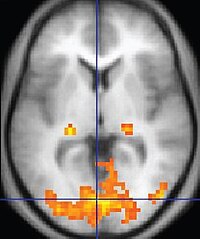
Photo from wikipedia
Substantial information related to human cerebral conditions can be decoded through various noninvasive evaluating techniques like fMRI. Exploration of the neuronal activity of the human brain can divulge the thoughts… Click to show full abstract
Substantial information related to human cerebral conditions can be decoded through various noninvasive evaluating techniques like fMRI. Exploration of the neuronal activity of the human brain can divulge the thoughts of a person like what the subject is perceiving, thinking, or visualizing. Furthermore, deep learning techniques can be used to decode the multifaceted patterns of the brain in response to external stimuli. Existing techniques are capable of exploring and classifying the thoughts of the human subject acquired by the fMRI imaging data. fMRI images are the volumetric imaging scans which are highly dimensional as well as require a lot of time for training when fed as an input in the deep learning network. However, the hassle for more efficient learning of highly dimensional high-level features in less training time and accurate interpretation of the brain voxels with less misclassification error is needed. In this research, we propose an improved CNN technique where features will be functionally aligned. The optimal features will be selected after dimensionality reduction. The highly dimensional feature vector will be transformed into low dimensional space for dimensionality reduction through autoadjusted weights and combination of best activation functions. Furthermore, we solve the problem of increased training time by using Swish activation function, making it denser and increasing efficiency of the model in less training time. Finally, the experimental results are evaluated and compared with other classifiers which demonstrated the supremacy of the proposed model in terms of accuracy.
Journal Title: Computational and Mathematical Methods in Medicine
Year Published: 2022
Link to full text (if available)
Share on Social Media: Sign Up to like & get
recommendations!